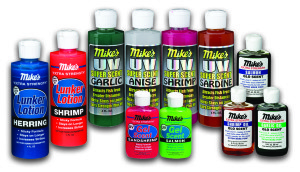Atlas-Mike: A Leader In Fishing Scents
The Good Sense In Using Scents
By Trey Carskadon
2014 has provided some compelling challenges for freshwater anglers. Scarce water has drawn down a number of popular reservoirs and pulled dozens of rivers and streams to a trickle. There’s pluses and minuses in dealing with these challenges. Certainly, less water confines fish to smaller areas but it often results in warmer water which profoundly affects the bite on salmonids (salmon, steelhead and trout) but can excite the bite in warmwater species like bass, bluegill and other panfish.
In all cases, you’ll likely have to be more stealthy and pay even closer attention to the fine details. That means longer casts with lighter line and work to keep your gear further away from the boat. Certainly, fluorocarbon leaders are one of the many details that pay dividends but one that’s often overlooked and should be used even when conditions are optimum are scent products.
Over the years, scents have been misunderstood. They’re popular in northern California, the northwest and into Alaska but receive surprisingly little use in other parts of the country. This is due in large part to them being oversold as some kind of magic in a bottle. “Just put this stuff on and stand-back.”
Still, scents are as essential to fishing success as sharp hooks, matched rods and reels and selecting the right bait or lure. Outstanding results are the product of doing lots of things right consistently.
At the very least, scents mask potentially offensive human odors. Ideally, they cause fish to commit to the bait more aggressively than not using scents. That is, timid biters become aggressive biters.
Bass for example, respond exceptionally well to scents. Look at the popularity of scented worms to confirm that. Crawdad scents, baitfish and nightcrawler are all excellent choices. Understanding what the forage is in the area and duplicating the profile and look (color) of the bait while applying the appropriate scent is a strong strategy. Having fished numerous plastic worm types, there’s no doubt that a dab of scent results in bass staying with the bait longer than plastics fished without scent.
Salmon, steelhead and trout are suckers for scent too.
Salmon, Chinook salmon especially, have a large olfactory nerve and acute sense of smell. Appealing to that sense and using sardine, herring or even garlic scent delivers a significant advantage to the angler than those who choose to forego the use of scent products. The same is true for steelhead and trout. Shrimp oil has been a longtime favorite for steelhead and nightcrawler and minnow scents have been winners for trout.
Garlic scents have come on strong for a number of fish species this past decade. From bass to salmon, guides and recreational anglers have taken to using garlic based scents on plugs and baits.
Atlas-Mike’s has been a world leader in the development of scent products for fishing. Mike’s scent oils are legendary and have been used far and wide by steelhead and salmon anglers for eons. Mike’s Lunker Lotions and UV scents have come on strong in recent years adding even more horsepower to these tried-and-true scent products.
Atlas-Mike’s, also the makers of dozens of different salmon eggs used for fishing, has taken these scents to new levels with tested amino acids, colors and UV enhancements that make their scents even more effective than ever.
But Mike’s would be the first to admit…they are not the silver bullet in fishing. Scents are an essential detail that shouldn’t be overlooked and will help in convincing fish that your offering is the one to bite.
And that is the good sense in the use of scents.
atlasmikes.com
(920) 563-2046




